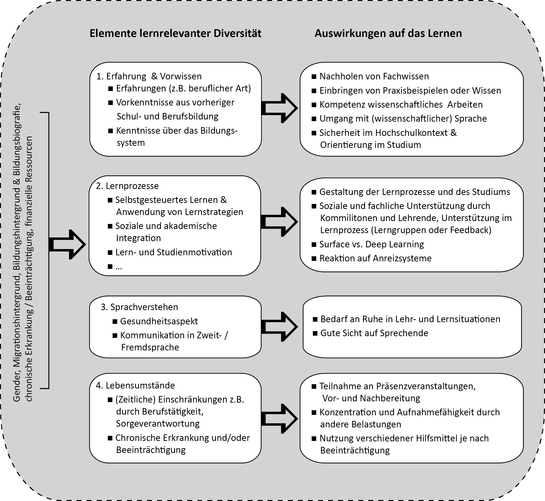Concept of learning-relevant diversity in education
Imke Buß
Diversity among students is often considered from traditional perspectives such as gender, educational background, life situation (e.g. parenthood, employment) or migration background. The following is an overview of the research on the study situation of different student groups, i.e. the currently frequent consideration of student diversity.
With regard to the composition of the student body and the study situation of parents or students with disabilities, Middendorff et al. (2013) analyze the nationwide social survey. Krenmayr (2008) and Kunadt et al. (2014) show that students with children interrupt their studies more frequently and therefore take longer to complete them. The compatibility of studies and extracurricular duties is also the focus of numerous analyses among working students (Kunadt et al. 2014; Brandstätter and Farthofer 2003; Sprietsma 2015). All of these aspects deal with the living situation of students and often include gender. The educational background or migration background of the students is often the focus of attention. Using the example of graduates from working-class backgrounds, El-Mafaalani (2012) shows that parts of this group struggle with resistance and a lack of understanding towards the desire to study and distance themselves from their backgrounds. Students from non-academic homes are more concerned about completing their studies (Fischer 2015). Finally, graduates with a Turkish migration background try to meet the high educational aspirations of their families and at the same time the expectations of the majority society (El-Mafaalani 2012). Bargel (2010) demonstrates that students are disadvantaged due to their social background, particularly when it comes to accessing higher education. Differences in performance are hardly recognizable, only the "cultural and social security in the academic milieu" has a negative effect on students' confidence in oral examination situations (Bargel 2010). The sensitivity of universities and teaching staff to the life situations and challenges of their diverse student body is certainly a credit to this research on student diversity.
However, the question arises in the course as to which aspects of diversity specifically influence the learning process and thus promote or hinder learning success. Is there a causal relationship between learning success and, for example, gender or migration background? Or are there other causes behind the disadvantages perceived by foreign students or students with a migration background, for example? How can teachers achieve the best learning outcomes for their diverse students through the design of their education? To answer these questions, the results of a comprehensive literature review focusing on the impact of diversity on education are presented below. The result of the analyses is the concept of learning-relevant diversity (see Figure 1). The aim of the concept is to capture important indicators of student diversity that provide a kind of "lens" for teachers when designing their education. However, the concept does not claim to be exhaustive. Furthermore, it is a theoretical concept that has not been empirically tested.
In their research report, Szczyrba et al. (2012) use the example of Cologne University of Applied Sciences to show for the first time factors influencing learning under the term "learning-relevant diversity". These include the students' own activity and motivation, self-reflection on the learning process by the students and their interest in studying. Viebahn (2008) analyzes learning differences from the perspective of educational psychology. He presents numerous differentiated aspects of learning differences, which are also used below. For example, he distinguishes between cognitive (knowledge, intelligence) and affective dispositions (motives and learning attitudes) in learning dispositions. Students' ability to organize their studies (information procurement, learning control, etc.) varies just as much as their reasons for choosing a course of study and their interest in the subject (Viebahn 2008, pp. 27, 57). Finally, the author points to the different living conditions of students.

Figure 1: Concept of diversity relevant to learning and selected effects on learning
Literature: Artelt and Lompscher (1996); Berg et al. (2014); Buß (2016); Fischer (2015); Viebahn (2008); Corleis (2012); Szczyrba et al. (2012). Own representation.
Figure 1 summarizes the elements of learning-relevant diversity and shows selected effects of diversity on learning. The concept draws on the results of numerous research studies and brings them together. The individual elements of diversity relevant to learning are presented below.
First of all (1), students begin their studies with certain previous experiences from their previous life (e.g. from work or experience abroad). Under certain circumstances, these experiences can be helpful for individual or group-related learning processes and therefore of interest to teachers. On the one hand, prior knowledge refers to the school or professional career, which is often measured in the form of the qualification for university entrance. Prior knowledge can also refer to knowledge about the higher education system or behavior within the university. We know from research on vocationally qualified students that this group has advantages in terms of learning organization as well as having to overcome subject-specific challenges (e.g. in mathematics, English) (Berg et al. 2014). Depending on their educational or migration background, students and their families are differently well informed about the higher education system; this can lead to differences in the appropriate choice of subject or orientation at the university (Viebahn 2008, p. 41 f.; Becker 2010).
The (2) learning processes are influenced by numerous psychological and social factors. The ability to learn and work in a self-directed manner facilitates both the preparation and follow-up of courses and examinations as well as the independent development of learning content. Weinert defines this self-direction as "the person acting can influence the essential decisions as to whether, what and whereupon he learns in a serious and consequential way" (Weinert 1982, p. 102). Self-direction is particularly important in teaching formats where the learning content or learning paths are not predetermined (e.g. in projects, homework or virtual education). However, repetition and application processes when learning for exams after well-prepared lectures also require the control of learning processes. Learning strategies play an important role in self-directed learning. Organizing learning alone or in a learning team, critically reviewing or repeating and checking the success of these strategies is a challenge for many students (Artelt and Lompscher 1996). Finding good learning strategies for oneself in the learning process influences learning success and can be demanded and encouraged by university lecturers. Learning activities are supported by the motivation to complete the course. A distinction can be made here between interest in the subject and achievement motivation (Viebahn 2008, p. 72 ff.). Meeuwisse et al. (2010) show that activating learning environments have a significant influence on the social and academic interaction of teachers with students and influence overall academic success. Learning formats that promote the interaction and integration of students (e.g. through teacher feedback or learning groups) have a positive impact on academic progress, triggered by the feeling of belonging to the university (Tinto 1975). This is also shown by the results of a recent study at the Ludwigshafen University of Business and Society (Buß 2016).
Difficulties in understanding speech (3) are caused in courses where there is so-called "quiet noise". This noise is caused by background noises that make it difficult to focus on the person who is currently speaking (teaching). Students with peripheral or central hearing impairments and students who communicate using a second or foreign language are particularly affected by this (Corleis 2012). In lectures as well as in group work, educators can take care to keep the noise as low as possible.
Finally, life circumstances have an impact on study behavior. Time constraints (4), for example due to work or family obligations, increase the challenges of regularly attending courses in a concentrated manner or finding time for self-study (Van Den Berg and Hofman 2005, p. 427). Finally, a variety of physical and psychological disabilities influence learning.
Brief descriptions of the diversity dimensions relevant to learning can be found in this toolbox. Which teaching format, method or examination takes the diversity dimensions into account and how was analyzed in the analysis of common teaching methods. These analyses can also be found in the toolbox.
Literature
Artelt, C.; Lompscher, J. (1996): Learning strategies and study problems among Potsdam students. In: Lompscher & Mandl. Education and learning problems in higher education. Bern: Verlag Hans Huber.
Bargel, T. (2010): Barriers and disadvantages for those entering higher education. Constance.
Berg, H.; Grendel, T.; Haußmann, I.; Lübbe, H.; Marx, A. (2014): The transition of vocationally qualified persons to higher education - results of a model project in Rhineland-Palatinate. In: Mainz contributions to higher education development (20). Available online at www.studieren-ohne-abitur.de, last checked on 03.02.2016.
Brandstätter, H.; Farthofer, A. (2003): Influence of employment on academic success. In: Journal of Industrial and Organizational Psychology A&O (47 (3)), pp. 134-145.
Buß, I. (2016): Unpublished results of a student survey as part of the Open Study Model Ludwigshafen project. Ludwigshafen.
Corleis, B. (2012): Activity and participation of students under the diversity aspect of "impairments in language comprehension" in education/learning situations at universities. Presentation at the 41st Annual Conference of the German Association for University Didactics. Mainz. Available online at www.blogs.uni-mainz.de/zq/files/2018/04/Doc-Corleis.pdf, last checked on 17.06.2020.
El-Mafaalani, A. (2012): Educational climbers from disadvantaged backgrounds. Habitus transformation and social mobility among natives and people of Turkish origin. Wiesbaden: Springer VS.
Fischer, T. (2015): Do students without an academic educational background worry more about their studies? An analysis in the context of teaching conditions. In: Kathrin Rheinländer (ed.): Inequality-sensitive university teaching. Positions, prerequisites, perspectives. Wiesbaden: Springer VS, pp. 177-197.
Krenmayr, J. (2008): Studying with a child. Female students between the lecture hall and the nursery. Diploma thesis. Vienna.
Kunadt, S.; Schelling, A.; Brodesser, D.; Samjeske, K. (2014): Family friendliness in practice: results from the project "Effektiv!-Für mehr Familienfreundlichkeit an deutschen Hochschulen". In: GESIS Center of Excellence - Women and Science (18), p. 1-100.
Meeuwisse, M.; Severiens, S. E.; Born, M. P. (2010): Learning Environment, Interaction, Sense of Belonging and Study Success in Ethnically Diverse Student Groups. In: Research in Higher Education 51 (6), pp. 528-545.
Middendorff, E.; Apolinarski, B.; Poskowsky, J.; Kandulla, M.; Netz, N. (2013): The economic and social situation of students in Germany 2012: 20th Social Survey of the Deutsches Studentenwerk conducted by the HIS Institute for Higher Education Research. Available online at www.sozialerhebung.de/download/20/soz20_hauptbericht_gesamt.pdf, last checked on 25.04.2016.
Sprietsma, M. (2015): Student employment: advantage or handicap for academic achievement? Discussion Papers, 15-085, ZEW.
Szczyrba, B.; van Treeck, T.; Gerber, J. (2012): Diversity relevant to education and learning at Cologne University of Applied Sciences. Research report.
Tinto, V. (1975): Dropout from Higher Education: A Theoretical Synthesis of Recent Re-search. In: Review of Educational Research (45 (1)), pp. 89-125.
van den Berg, R.; Hofman, A. (2005): Student Success in University Education: A Multi-measurement Study of the Impact of Student and Faculty Factors on Study Progress. In: Higher Education 50 (3), pp. 413-446. DOI: 10.1007/s10734-004-6361-1.
Viebahn, P. (2008): Lernverschiedenheit und soziale Vielfalt im Studium: Differentielle Hochschuldidaktik aus psychologischer Sicht. Bielefeld: UVW Webler.
Weinert, F. (1982): Self-directed learning as a prerequisite, method and goal of teaching. In: Unterrichtswissenschaft (2), pp. 99-110.
Citation
Buß, Imke (2017): Taking learning-relevant diversity into account in education?! In: Rump, Jutta; Buß, Imke; Kaiser, Janina; Schiedhelm, Melanie; Schorat-Waly, Petra: Toolbox for good education in a diverse student body. Working Papers of the Ludwigshafen University of Business and Society, No. 6.
Use according to Creative Commons under attribution (please use the citation provided) and for non-commercial purposes.
